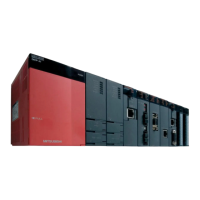10 - 39
10.3 Programming Using MELSEC Data Link Functions
10.3.4 Programming using MELSEC data link functions
10
FUNCTIONS AND PROGRAMMING
(b) Precautions for access to CC-Link module's self station devices and other
station programmable controller devices
When making access via a CC-Link module, provide interlocks depending on the
link status of the self station and other station.
1) Access to self station device
Create a user program that will provide interlocks to validate data writing to or
data reading from the self station device.
Data becomes effective only when the following conditions are satisfied.
• Module error (Xn0) is OFF (normal)
• Self station data link status (Xn1) is OFF (in data link).
• Module ready (XnF) is ON (operable).
However, even if the above conditions are not satisfied, write/read processing
to/from the self station is normally terminated.
2) Transient access to other stations (other station programmable
controller CPU remote operation and device access)
Create a user program so that access will be made when the following
condition is satisfied, in addition to the interlocks for access to the self station
device.
• Data link status of the access target station (Bits corresponding to a
communication target station of SW80 to 83, which are read from the self
station) is OFF (normal communication).
(c) Precautions for access to MELSECNET/H module's self station devices and
other station programmable controller devices
When making access via a MELSECNET/H module, provide interlocks depending
on the link status of the self station.
1) Access to self station device
Create a user program that will provide interlocks to validate data writing to or
data reading from the self station device.
Data becomes effective only when the following conditions are satisfied.
• Module status (SB20) is OFF (normal)
• Baton pass status (self station) (SB47) is OFF (normal).
• Data link status of self station (SB49) is OFF (in data link).
However, even if the above conditions are not satisfied, write/read processing
from/to the self station is normally terminated.
2) Transient access to other stations (other station programmable
controller CPU remote operation and device access)
Create a user program so that access will be made when the following
condition is satisfied, in addition to the interlocks for access to the self station
device.
• Baton pass status of the access target station (Bits corresponding to the
communication target station of SW70 to 73, which are read from the self
station) is OFF (normal communication).
• Data link status (Bits corresponding to the communication target station of
SW74 to 77, which re read from the self station) is OFF (normal
communication).
